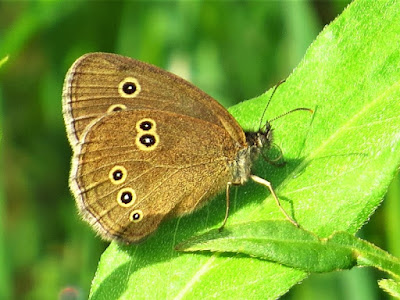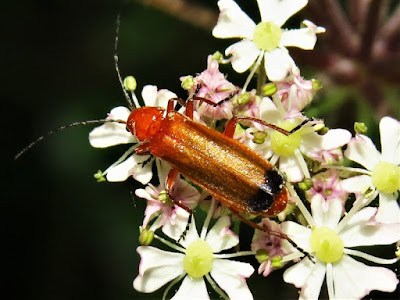13.0°C > 16.0°C: Low overcast began to break after 08:15. A calm start with a very light NW breeze later. Moderate visibility and rather hazy.
Sunrise: 04:56 BST
* = a photo today
Priorslee Lake: 04:45 – 05:45 // 06:45 – 08:55
(155th visit of the year)
Bird notes:
- For the first day since 09 February I heard no Blackbird singing.
- House Sparrows are still regularly appearing on the dam-face. As far as I can tell they commute to here from around the houses alongside Teece Drive. There seems to be no nest site closer.
Birds noted flying over here:
- 2 Stock Doves: singles
- 41 Wood Pigeons
- 10 Lesser Black-backed Gulls
- 31 Jackdaws
- 1 Rook
Hirundines etc. noted:
None.
It is a very poor year for them after their late arrival. There seems to be roughly the usual number of Swifts around Newport with House Martin numbers much reduced.
Warblers noted (figures in brackets relate to singing birds):
- 12 (11) Chiffchaffs
- 3 (1) Sedge Warblers
- 10 (6) Reed Warblers
- 6 (4) Blackcaps only
Counts from the lake area:
- 2 + 4 (1 brood) Mute Swans
- 14 (?♂) Mallard
- 3 Moorhens: all adults
- 68 adult and juvenile Coots again
- 7 Great Crested Grebes
- 4 Black-headed Gulls: all adults: three other birds were on the football field at 05:35.
- 4 Lesser Black-backed Gulls: various ages
- 1 Grey Heron
Noted on / around the street lamp poles pre-dawn:
- *1 Leiobunum blackwalli harvestman
Warblers noted (figures in brackets relate to singing birds):
- 12 (11) Chiffchaffs
- 3 (1) Sedge Warblers
- 10 (6) Reed Warblers
- 6 (4) Blackcaps only
Counts from the lake area:
- 2 + 4 (1 brood) Mute Swans
- 14 (?♂) Mallard
- 3 Moorhens: all adults
- 68 adult and juvenile Coots again
- 7 Great Crested Grebes
- 4 Black-headed Gulls: all adults: three other birds were on the football field at 05:35.
- 4 Lesser Black-backed Gulls: various ages
- 1 Grey Heron
Noted on / around the street lamp poles pre-dawn:
- *1 Leiobunum blackwalli harvestman
A very poor showing
Noted later:
Noted later:
It stayed cloudy and it was breezy except where sheltered from West wind:
New for this year:
Butterflies:
- *Small Skipper (Thymelicus sylvestris)
Beetles:
- *the darkling beetle Lagria hirta.
Repeat sightings:
Butterflies:
- *Ringlet (Aphantopus hyperantus)
'white' butterflies are unusually scarce at the moment.
Moths:
- Common Marble (Celypha lacunana)
- Garden Grass-veneer (Chrysoteuchia culmella)
New for this year:
Butterflies:
- *Small Skipper (Thymelicus sylvestris)
Beetles:
- *the darkling beetle Lagria hirta.
Repeat sightings:
Butterflies:
- *Ringlet (Aphantopus hyperantus)
'white' butterflies are unusually scarce at the moment.
Moths:
- Common Marble (Celypha lacunana)
- Garden Grass-veneer (Chrysoteuchia culmella)
Bees, wasps etc.:
- *Common Carder Bee (Bombus pascuorum)
- Buff-tailed Bumblebee (Bombus terrestris)
- Common Wasp (Paravespula vulgaris)
- *Common Carder Bee (Bombus pascuorum)
- Buff-tailed Bumblebee (Bombus terrestris)
- Common Wasp (Paravespula vulgaris)
Hoverflies:
- Marmalade Hoverfly (Episyrphus balteatus)
- *Tapered Dronefly (Eristalis pertinax)
- Marmalade Hoverfly (Episyrphus balteatus)
- *Tapered Dronefly (Eristalis pertinax)
Dragon/Damselflies
- Common Blue Damselfly (Enallagma cyathigerum)
- Hawker sp. As usual it saw me first and shot off.
- Common Blue Damselfly (Enallagma cyathigerum)
- Hawker sp. As usual it saw me first and shot off.
Other flies:
- Black Snipefly (Chrysopilus cristatus)
- Black Snipefly (Chrysopilus cristatus)
Beetles:
- *Common Red Soldier Beetle (Rhagonycha fulva)
- pollen beetles as usual.
- *Common Red Soldier Beetle (Rhagonycha fulva)
- pollen beetles as usual.
Bugs:
- Common Flower Bug (Anthocoris nemorum)
- *Common Froghopper (Philaenus spumarius)
- Common Flower Bug (Anthocoris nemorum)
- *Common Froghopper (Philaenus spumarius)
Snails / Slugs etc.
- White-lipped Snail (Cepaea hortensis)
- White-lipped Snail (Cepaea hortensis)
My first Small Skipper butterfly (Thymelicus sylvestris) of the year. The trailing edge of the wing on Small Skipper is a dark line whereas the similar Large Skipper (Ochlodes sylvanus) has dark patterning along the trailing edge. (When fresh both species show pale fringes that soon wear off).
A Ringlet butterfly (Aphantopus hyperantus) showing why it is so-named.
A typically scruffy Common Carder Bee (Bombus pascuorum).
It is some while since I showed a 'real' Tapered Dronefly (Eristalis pertinax). It is male which is why it looks tapered. Had it been a female then the same pale legs would have identified it as this species rather than any of the other Eristalis drone flies.
This is the darkling beetle Lagria hirta, distinguished by its rather hairy appearance.
A Common Red Soldier Beetle (Rhagonycha fulva).
And here a pair (one assumes!) apparently of a little known Thistle Bonking Beetle form!
In this buttercup flower are four tiny pollen beetles. Note that on the lowest leaf there is an even smaller fly. I cannot identify any of them.
A close-up does not help much.
What look to be a different species of pollen beetle, here deep in a flower of Field Bindweed (Convolvulus arvensis).
A Common Froghopper (Philaenus spumarius). This species comes in a multitude of colours and patterns.
This seems to be the harvestman Leiobunum blackwalli. Separation of this species from L. rotundum is easiest by looking at the eye surround. Confusingly it is L. blackwalli that has the "white-wall tyre" eye surround, as here. (Does anyone know what white-wall tyres are these days? Or why so many people bought them in the 1950s?)
The aircraft of the day. A relative rarity these days is a four-engines passenger aircraft. This is an Airbus A340 300 series of Swiss International Airlines – you can see the white cross on the tail. It is en route from Chicago's O'Hare International Airport to Zurich Airport. Although these are not as economical to fly as more modern twin-engined jets you have to have the $300 million to buy a new one.
(Ed Wilson)
------------------------------------------------------------------------------------------------------
The Flash: 05:50 – 06:40
(151st visit of the year)
Bird notes:
- Checking my records for last year (2021) there were up to 150 Canada Geese and about 45 Greylag Geese here during the time they were flightless. So there are more of both species this year.
- Many juvenile Moorhens and Coots are now independent and I cannot reliably ascribe these to any brood. It is apparent that later broods are having a much better survival rate than early broods.
- After several quiet days there were as many Blackcaps singing here as I heard around the balancing lake.
Birds noted flying over here:
- 1 Lesser Black-backed Gull
Hirundines etc. noted yet again:
None
Warblers noted (figures in brackets relate to singing birds):
- 5 (3) Chiffchaffs
- 4 (4) Blackcap
Noted on / around the water:
- 216 Canada Geese
- 1 Canada x Greylag Goose
- 84 Greylag Geese
- 5 + 4 (1 brood) Mute Swans
- 25 (?♂) Mallard: no ducklings seen
- 1 all-white duck (Aylesbury Duck)
- 13 (?♂) Tufted Duck
- 7 + 10 (? broods) Moorhens
- 19 + 15 (? broods) Coots
- 2 Great Crested Grebes
Noted on / around the street lamp poles or elsewhere
- 1 Garden Grass-veneer moth (Chrysoteuchia culmella)
- 1 Common Grey moth (Scoparia ambigualis)
- *1 Common European Earwig (Forficula auricularia): presumed dead after being in the jaws of a spider yesterday.
- 2 Opilio canestrinii harvestmen
Also noted elsewhere
- 1 Grey Squirrel
- 5 (3) Chiffchaffs
- 4 (4) Blackcap
Noted on / around the water:
- 216 Canada Geese
- 1 Canada x Greylag Goose
- 84 Greylag Geese
- 5 + 4 (1 brood) Mute Swans
- 25 (?♂) Mallard: no ducklings seen
- 1 all-white duck (Aylesbury Duck)
- 13 (?♂) Tufted Duck
- 7 + 10 (? broods) Moorhens
- 19 + 15 (? broods) Coots
- 2 Great Crested Grebes
Noted on / around the street lamp poles or elsewhere
- 1 Garden Grass-veneer moth (Chrysoteuchia culmella)
- 1 Common Grey moth (Scoparia ambigualis)
- *1 Common European Earwig (Forficula auricularia): presumed dead after being in the jaws of a spider yesterday.
- 2 Opilio canestrinii harvestmen
Also noted elsewhere
- 1 Grey Squirrel
I assume this is an empty shell of a Common European Earwig (Forficula auricularia) as this was the individual I photographed in the jaws of a spider yesterday. It looks to be partially wrapped up in spider silk.
(Ed Wilson)
------------------------------------------------------------------------------------------------------
Between the lake and The Flash:
- Moorhen(s) heard only at the upper pool.
- Two juvenile Moorhens glimpsed scampering off the grass at the lower pool: perhaps from different broods?
(Ed Wilson)
------------------------------------------------------------------------------------------------------
In the Priorslee Avenue tunnel:
- Nothing of note
(Ed Wilson)
------------------------------------------------------------------------------------------------------
On this day can be found via the yearly links in the right-hand column.
Sightings from previous years without links are below
2007
Priorslee Lake
A pair of Siskins close to the lake
(Martin Adlam)













